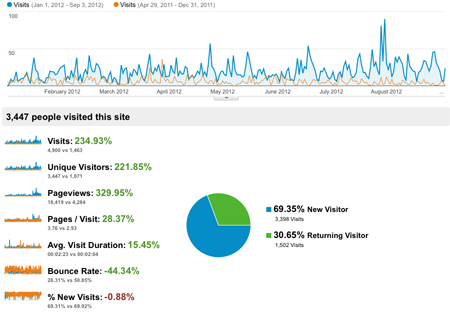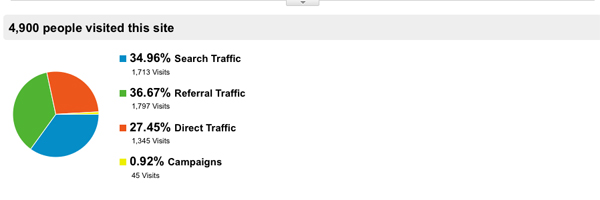You are viewing our site as a Broker, Switch Your View:
Agent | Broker Reset Filters to Default Back to ListHow to Double Your Real Estate Website Traffic
September 06 2012
 We've been building websites for real estate agents for quite some time now. Every new agent that comes to us is after the same thing:
We've been building websites for real estate agents for quite some time now. Every new agent that comes to us is after the same thing:
They want more web traffic and more leads.
Increased traffic and better conversion rates seem to be the top of mind for everybody we come across. So today, I thought I'd give you a little advice about increasing traffic. Not just increasing traffic, BUT how to more than double your site traffic.
While the site construction itself (e.g. meta data, keywords, page descriptions, page copy written that specifically references keywords, page naming conventions, etc) is responsible for much of the traffic you are going to get driven to your site, the fact of the matter is that elbow grease is a must if you want to get big increases in traffic.
Managing your online presence is difficult and takes time. Supposed social media "experts" claim that it is easy and that anyone can do it. I disagree with this. While there certainly is a formula you can use to reach your goals, at the end of the day, it all boils down to persistence, dedication and work. In other words, once again, "There's no such thing as a free lunch."
So what is this magic bullet, that will double your website traffic, even if it does require a little bit of elbow grease? It's very simple--BLOGGING!
I know, I know. You are busy and don't have time for blogging. But what if you could double your site traffic or, even more, triple it? That would be worth it wouldn't it? What if there were sources that you can access to give you ideas of what to blog about? What if you could get a blog out in as little as 30-45 minutes per week? That would be worth it, right? Here are some tips on how you can make this happen.
DISCLAIMER: Now before I dive into this, I have to admit that in the beginning, I was as guilty as the prospective clients that come to my office for help with their websites. My company was egregiously blowing it when it came to managing our online presence. Much like the cobbler who had children running around town without shoes, we spent all our time working on our client's projects and neglecting our own internal projects.
To remedy this, our 2012 New Year's resolution was to blog regularly, a minimum of once per week. After six months, we would track our Google Analytics and see where we were compared to the six months prior. Today, I will share those reports with you, Analyzing January 1 through September 3rd, 2012 and comparing it to the time period prior. I will then also give you tips on how you can execute a blogging plan that will not be burdensome on your already busy schedule.
THE NUMBERS

So as you can see, by regularly creating fresh, new content for our website, via our blog, we are winning the battle. Some key things to note:
- A 221% increase in unique visitors equates to almost 3.5 times more visitors. It's hard to make a case for being too busy to spend 30-45 minutes per week to get this kind of increased traffic.
- Almost 70% of the traffic to our site was from new visitors (no doubt attracted by the content we were posting).
- The average time per visit to our website is up over 15%. Again, a testament to the quality of the content we are providing on our blog.
- Our bounce rate is down significantly. What that basically means is that people that go to our site are staying engaged with it and not simply landing on it and leaving immediately.

Perhaps more valuable than the traffic reports, though, is a quick look at where the visitors that come to our site are coming from. As you can see above, almost 72% of the traffic that has come to our site this year was from search engine referrals, or from referrals from other sites. Before we started regularly blogging, almost 80% of our traffic was in the "direct traffic" category.
While we want all the traffic we can get, we DO NOT want direct traffic to be the bulk of our web traffic. You see, that means the user would have to type our website URL directly into a browser to get to our site. That means those people most likely already know us. Search and referral traffic, on the other hand, are people that most likely don't know us and found us via a Google search, or perhaps a link on someone else's website. That is PERFECT! New prospects that we can convert into customers.
Do we want more web traffic? Of course. The fact of the matter is that this stuff does not happen overnight. Typically, when we start an online marketing initiative for a client, we see that it takes 4-6 months to build up steam and then, after that, it starts taking on a life of its own and becoming a fast mover. Because of the numbers we have seen this year, and because we are dead set on staying consistent with this, we predict 3-4 times the amount of monthly traffic to our site in the next quarter. It's hard work, but once you have the momentum, the payoff is huge.
HOW DO YOU DO IT?
Okay, so you have seen our numbers and see that there is a compelling reason to set up a blogging strategy for your real estate practice. How exactly do you do it? Here are a few "ground floor" tips for you to consider when setting up your strategy for blogging.
CONTENT - Content seems to be the bane of every real estate agent's existence. People that come to our office all seem to share the thought that after 3-4 weeks of blogging, they are going to run out of things to talk about. The truth though is that this is simply not true.
Here are a few great examples of content you can use and places you can look to get inspired:
1) Market Trends
Market trends are something you can guarantee people will be interested in. Even more, when you post market trends and then analyze them so that even the "average Joe" can understand them, this puts you in the homeowner's mind as "Neighborhood Expert." That will make them want to call you to interview you when they are ready to put their home on the market.
If you work for a big box brokerage, you no doubt have an in-house system that can generate market trends for your farm area(s). If though you are an independent REALTOR® or work for a small boutique firm, there are plenty of choices out there for third party systems. Two of my favorites are Altos Research, and The Real Estate Report.
2) Your Listings
This one should be a no-brainer. After all, what better way to show you are active and successful as a REALTOR® than advertising your listings? Keywords and post tags will help you show up in Google searches by potential buyers looking for a home in the neighborhood where your listing is located. This is fantastic, because most buyers start their home search online before they have contacted a REALTOR® to work with them. This means you'll get first crack at them.
3) Use Your Broker
You have to go to weekly broker meetings, right? Use them to your advantage. In my 15 years helping REALTORS® with marketing, I bet I have been to close to 500 broker meetings. Every single manager at these meetings always has materials to hand out to their agents at the meetings. You can use this info as content for your blog. The content, almost always, is specific to the area and market the brokerage serves, and it always is real estate related, timely and very topical to what is going on in the media at that given time.
This could perhaps be a post that only takes 10 minutes to complete. At bare minimum, just write a paragraph analyzing the material that your broker gave you. Then, link out to the full article, or attach a link that you can give the reader to download the material your broker gave you. Easy and simple.
4) Places To Get FREE Content Ideas
Besides your broker meetings, there are other great places you can go to get great suggestions for blog topics. It's just as simple as doing a quick search on the internet. One of my favorite spots to find great content ideas is on Emily Williams' blog on RETechnology.com.
Every month, Emily posts a list of some fantastic topics you can use throughout the month on your blog. With a little bit of research online, everyone should be able to find content to fill a topic she suggests.
FINAL NOTE: Creation is the first part. Promotion is the money shot
While regular creation of custom, original content on your blog is important, getting it out there is even more important. In fact, we generally suggest to our clients to spend 20% of their time creating the content and then 80% of their time promoting it.
Promotion goes hand in hand with conversion. For my next article, I'll give you tips on how to maximize both, making sure that all this work adds to your bottom line and gets you more clients.
To view the original article, visit the Leading Agent blog.









